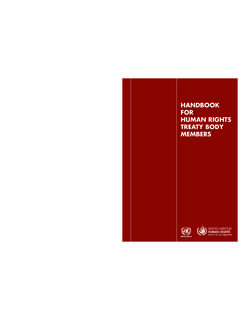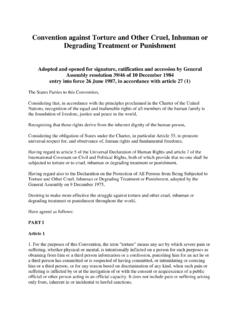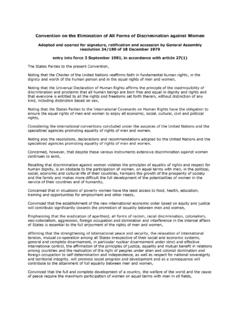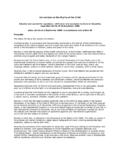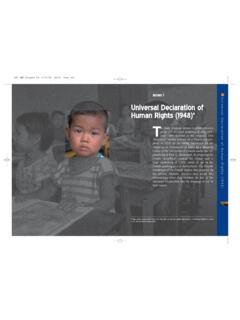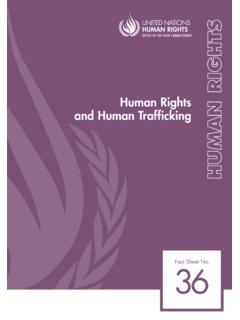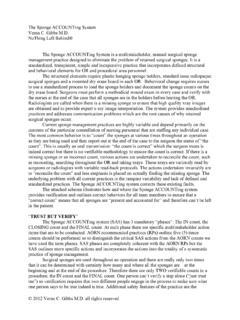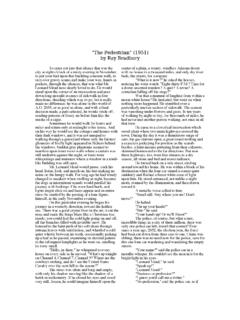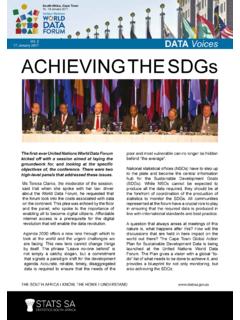Transcription of A HUMAN RIGHTS-BASED APPROACH TO DATA - OHCHR
1 A HUMAN RIGHTS-BASED . APPROACH TO data . LEAVING NO ONE behind IN THE 2030. AGENDA FOR SUSTAINABLE DEVELOPMENT. DISA. N G. TIO GR. E. IPA GA. TIC TI. O. AR. P. N. SEL. UNTABILITY. F-IDENTIFICATION. ACCO. PR CY. N. IVA RE. CY SPA. T RA N. GUIDANCE. NOTE TO data . COLLECTION. AND DISAGGREGATION. OHCHR thanks the numerous experts OHCHR welcomes and organizations from the HUMAN rights , comments or suggestions on this guidance development and statistics communities who note and any information on experiences, took part in the development and validation practices and research work relevant to the of the guidance outlined in the present note, implementation of an HRBAD. including the experts who attended a meeting on a HUMAN RIGHTS-BASED APPROACH to data (HRBAD) in Geneva.
2 This meeting was made possible with the financial support of the Government of Finland. United Nations 2018. This guidance note has been printed with the financial contribution of the European Union. The contents of this guidance note are the sole Printed during the 70th Anniversary of responsibility of the United Nations and can in no way the Universal Declaration of HUMAN rights . be taken to reflect the views of the European Union. CONTENTS data 11. 1. INTRODUCTION. In step with the 2030 Agenda for Sustainable develop communities of practice that improve Development (2030 Agenda) and its the quality, relevance and use of data and Sustainable Developments Goals (SDGs) statistics consistently with international HUMAN adopted by Heads of State and Government rights norms and principles.
3 This note draws at the United Nations Summit in September from internationally agreed principles for 2015 (A/RES/70/1), this note aims to statistics4 and echoes the call for a data provide general guidance and elements revolution for sustainable development5, of a common understanding on a HUMAN which upholds HUMAN rights . It should be of RIGHTS-BASED APPROACH to data (HRBAD), interest to all policymakers, statisticians or with a focus on issues of data collection and data specialists (in government agencies or civil society organizations (CSOs)), development practitioners and HUMAN As part of the 2030 Agenda, States explicitly rights advocates eager to ensure respect, reaffirmed their commitment to international protection and fulfilment of HUMAN rights in law and emphasized that the Agenda is to the measurement and implementation of the be implemented in a manner that is consistent 2030 with the rights and obligations of States under A preliminary set of principles, recommenda- international They pledged to leave no tions and good practices were formulated one behind and for more systematic data under the following headings of an HRBAD.
4 Disaggregation to help achieve and measure the As devising disaggregation of P articipation indicators (or not) is not a norm or value- ata disaggregation D. neutral exercise, and the risks associated with this operation for the protection of the elf-identification S. rights of data subjects cannot be denied, an T ransparency HRBAD has much to offer in this context. As P rivacy outlined in this note, an HRBAD helps bring together relevant data stakeholders and ccountability A. 2. PARTICIPATION Participation is central to a HUMAN rights - based APPROACH . It is instrumental to the realization of all components of the HRBAD, as well as retaining trust in official and other relevant data and Participation of relevant Involvement of groups of population groups in data interest in all aspects of data collection exercises, including collection activities planning, data collection, All data collection exercises should include dissemination and analysis of data means for free, active and meaningful participation of relevant stakeholders, in particular the most marginalized population groups.
5 Participation should be considered in KEY PRINCIPLES: relation to the entire data collection process: from strategic planning through identification Consider a range of of data needs; selecting and testing an processes that facilitate and encourage participation appropriate collection methodology; data Clearly communicate how collection (for instance, hiring interviewers participatory processes are from particular communities to improve conducted and the outcomes response rates); and to data storage, of these exchanges dissemination, analysis and Ensure that the views of vulnerable or marginalized In some contexts, it may not be possible or groups, and groups who are appropriate to engage directly with certain at risk of discrimination, are represented groups.
6 This may be the case where: Maintain knowledge their legal status makes engagement holdings and institutional with government agencies difficult or memory in relation to risky information gathered through participatory processes social stigma and negative stereotypes create negative ramifications for publicly identifying with the group 3. the group is so marginalized and/ should be empowered not only in terms of or disadvantaged as to lack of understanding data collection processes, access, ability or resources to engage but in the use of the resulting data (see productively in participatory processes Accountability' below).10. Where appropriate, CSOs, National Where input from members of the public is HUMAN rights Institutions9 and other relevant sought, the outcomes of these consultation stakeholders should participate on behalf of processes should be made publicly these groups to provide relevant perspectives available.
7 Information provided by members and information (provided they are competent of the public through participatory processes to represent the group's interests). should be retained and appropriately Decision-making about archived to contribute to organizational participation should be knowledge holdings. Information gathered transparent and equitable through previous consultations and The process and decisions by which participatory processes should be reviewed participants are selected and groups to avoid over-burdening vulnerable groups. are engaged with should be clear and Where groups have participated in data transparent. Groups who wish to be collection processes, data collectors involved in participatory processes should should ensure that the resulting data is be able to access the relevant agencies for shared appropriately with these groups.
8 This purpose. This return' of data should be meaningful Participation is most effective when the to the population of interest and delivered groups involved are able to engage with in culturally appropriate ways. This research and data and see opportunities for demonstrates the impact of their inputs and its application in their own contexts. Capacity encourages their ongoing use of data and strengthening should be undertaken with engagement with the activities of the data participating groups and target populations collector. to increase their statistical literacy and understanding of the purpose and process of data collection. Marginalized groups 4. data collectors should Public submissions processes (for proactively consider instance, for topic development), with clear and transparent information participation options and about use of information submitted and groups to be represented decision-making processes To facilitate the participation of population Ongoing engagement and groups at risk of being left behind , it is relationship-building with communities to encourage participation, necessary to identify vulnerable groups, establish dialogues and incorporate namely the groups most at risk of not perspectives in data collection enjoying their HUMAN rights .
9 This should be processes done proactively through discussion with Including relevant CSOs in thematic National HUMAN rights Institutions, CSOs or advisory boards or committees and other relevant experts. convened by the data collector Creating advisory groups to facilitate The form of participation should be decided regular engagement with vulnerable on a case-by-case basis. Options may groups and frequent input on data include: collection processes Online consultations, with appropriate Establishing focal points within data access provisions and publicity to collection organizations who are ensure relevant groups are aware of responsible for seeking information and the consultation process perspectives from groups of interest Public meetings, in locations that Formal memoranda of understanding are easily accessible for vulnerable among organizations or departments, groups and with appropriate publicity including between national statistical and engagement to encourage offices and HUMAN rights institutions, participation to facilitate information sharing and collaborative Community visits.
10 Which may incorporate public meetings, A participatory APPROACH should enhance meetings with key stakeholders and the relevance and reliability of collected representatives and discussion with data and compiled indicators. An HRBAD. community members about issues relevant to data collection should help address concerns expressed by the target population groups themselves 5. in accordance with international HUMAN HUMAN rights Focal Points with a gender rights standards. These groups may be, perspective. for example, women; children; indigenous peoples; minorities; persons with disabilities;. migrants; homeless persons; older persons;. the youth; lesbian, gay, bisexual, transgender and intersex (LGBTI) persons; refugees.
